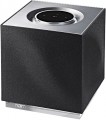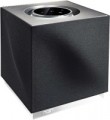-
AirPlay. AirPlay technology was developed by Apple. It is based on Wi-Fi and is used to wirelessly broadcast content from Apple devices to external audio systems. Thus, this function is useful for tech who want to connect an iPhone or iPod touch to the audio system, but do not want to bother with wires; However, it is possible to connect other devices via AirPlay - for example, a PC with iTunes and a Wi-Fi module installed.
-
AirPlay 2. The second generation of the AirPlay technology described above, introduced in 2018. Among the main innovations of this version is support for the multiroom format, that is, the simultaneous broadcast of several audio signals to different compatible devices installed in different places. In this way, you can, for example, turn on a radio broadcast of a news program in the living room, relaxing music in the bedroom, etc. In addition, AirPlay 2 received a number of other improvements - improved buffering, the ability to stream to stereo speakers, as well as support for voice control via Siri.
-
Chromecast. Original name: Google Cast. Technology for broadcasting content to external devices, developed by Google. Allows you to transmit an audio signal from a PC or mobile device to the audio system; the broadcast is usually carried out via Wi-Fi, while the receiver and the signal source must be on the same Wi-Fi network (with t
...he exception of Chromecast media players). Note that in signal sources (smartphones, tablets, PCs, etc.) Chromecast is implemented at the level of individual applications. For example, at the time of its creation, this feature was available, in particular, in the YouTube and Netflix applications for Android and iOS, as well as in the web versions of these applications for Chrome. Thanks to this format, this technology is extremely widespread these days, and the ability to connect a particular gadget to an audio system with Chromecast is usually limited to the ability to install appropriate applications on this gadget.
- DLNA. DLNA (Digital Living Network Alliance) is a standard that allows you to combine various types of home electronics and household appliances into a single network for content exchange and control. In the case of audio systems, DLNA can be used, for example, to play music from the disk of a computer connected to such a network, broadcast sound to a device installed in another room (for example, an amplifier), etc. Connecting to DLNA can be done either wired or wirelessly (using the Wi-Fi standard), and device compatibility does not depend on their manufacturers - the only condition is compliance with the DLNA standard.
- LAN. Standard interface for wired communication to local computer networks based on the RJ-45 connector. Its presence allows you to use various network functions, such as Internet radio (see "Advanced") or DLNA (see above). Compared to another network interface - Wi-Fi - LAN is less convenient due to the presence of wires, but is more reliable and provides a higher actual data transfer speed.
- Wi-Fi. The presence of a Wi-Fi wireless communication module in the audio system design. This technology is used both in computer networks and for directly connecting various devices to each other; its “range” is sufficient to work within residential premises, even through walls. In this case, Wi-Fi can be used to work with network functions such as Internet radio or DLNA(see above). Moreover, this option is more convenient than a wired LAN due to the absence of actual wires. In addition, support for this technology is a prerequisite for using the AirPlay and Chromecast functions (see above); and in some devices, Wi-Fi even allows you to connect smartphones, tablets and other gadgets as remote controls.
One of the most modern and fastest standards of this wireless communication technology is Wi-Fi 5. The 802.11ac version uses the 5 GHz band (less congested and more noise-resistant than 2.4 GHz), providing speeds of up to 1.69 Gbps per antenna and up to 6.77 Gbps with multiple antennas.
— Bluetooth. Direct wireless communication technology between various devices. One of the most popular ways to use Bluetooth in audio systems is to work with an audio signal, primarily broadcasting sound to wireless headphones or speakers; and some models also provide the ability to connect a smartphone, tablet or other device and use the audio system as an external Bluetooth speaker. However, it is worth considering that initially Bluetooth is noticeably inferior to a wired communication in terms of sound quality; however, in our time, this disadvantage is often compensated by the use of one or another version of the aptX codec(see below).
In addition, other options for using Bluetooth may be provided - for example, exchanging files between the built-in memory and the same smartphone, or remote control via an application. They are not mandatory for modern audio systems, but with the development of technology they are becoming increasingly widespread.
In modern audio systems, the Bluetooth v 5 standard is most often used. Its important innovation is the expansion of the capabilities of the BLE (Bluetooth Low Energy) mode: if necessary, the device can increase the range by reducing the speed, or speed up transmission at the cost of reducing the range. In addition, a number of improvements have been introduced regarding simultaneous work with multiple connected devices.
- aptX support. The audio system supports aptX, a codec designed to improve the quality of sound transmitted via Bluetooth. Accordingly, this function automatically means the presence of a built-in Bluetooth module (see above). The need to use special technologies is due to the fact that in the original Bluetooth format the audio signal is very highly compressed, which significantly affects the final sound quality. The aptX technology is designed to correct the situation: according to the creators, it provides sound purity “comparable to Audio CD (16-bit/44.1kHz)” and almost as good as a wired communication. This is often enough even for comfortable listening to lossless formats, not to mention MP3 and other popular compressed formats. Of course, to use aptX, the signal source must also support it.
- aptX HD support. Audio system support for the aptX HD codec - an improved and updated version of the aptX described above. This version claims sound purity comparable to Hi-Res audio materials (24-bit/48kHz); this allows you to comfortably listen not only to MP3, but also to lossless formats and even uncompressed audio materials. On the other hand, aptX HD support is quite expensive, and its advantages over the original aptX only become noticeable on very high-quality audio materials, for which consumer audio systems are rarely used. Therefore, this function is not particularly widespread.
- A.A.C. A codec used primarily in Apple portable devices to improve sound transmitted via Bluetooth. In this sense, it is similar to aptX (see the corresponding paragraphs), but is noticeably inferior to it in terms of capabilities: if the sound of aptX is compared with Audio CD, then AAC is at the level of an average quality MP3 file. However, for listening to the same MP3s, this is quite enough; the difference becomes noticeable only on more advanced formats.
-LDAC. Sony's proprietary Bluetooth codec. It surpasses even aptX HD in terms of bandwidth and potential sound quality, providing performance at the Hi-Res level of 24-bit/96kHz audio; there is even an opinion that this is the maximum quality that it makes sense to provide in wireless headphones - further improvement will simply be imperceptible to the human ear.
— Network streaming audio. The ability of the audio system to work with network streaming audio services such as Deezer, Spotify, Tidal, etc. Such services are designed to broadcast content (in this case, mainly music) over the Internet; in this case, the played files are not saved in the audio system, but are played directly from the corresponding resource on the World Wide Web. Nowadays, there are many streaming services that differ in the range of music and access conditions; The specific list of supported services should be clarified separately. However, in any case, the main advantages of online streaming include an extensive selection of content and almost instant access to the desired composition; Some services can also work like a radio, automatically selecting music according to the producer's preferences.
- Speakerphone. Possibility of using the device as a hands-free system for a mobile phone. In this mode, the audio system connects to the device, most often using Bluetooth (see above), and the voice of the subscriber on the other end of the line is output not to the phone, but to the speakers of the audio system. This is often more convenient than holding the phone to your ear; In addition, speakerphone is useful if several people need to participate in a conversation.
— NFC chip. NFC is a short-range wireless technology (about 10 cm). In audio systems, NFC is used primarily to facilitate communication via Wi-Fi or Bluetooth (see above). With this chip, you can simply bring an external NFC-compatible device to the audio system and confirm the communication - it's easier than manually adjusting settings.
